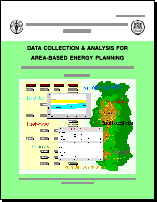

Data Collection & Analysis for Area-Based Energy Planning
A Case Study in Phrao District, Northern Thailand
Field Document No.48, May 1997
|
by Joost Siteur |
Table of Contents |
 The site-specific nature of rural energy asks for the area-based planning, i.e. demand and supply assessment, forecasting and plan formulation and implementation for a distinct area, defined either by administrative boundaries or by factors such as agro-ecology, economy, social or cultural characteristics. Unfortunately, at present energy planning in most RWEDP member countries occurs mainly at national level, with an emphasis on conventional fuels. Little if any practical experience of area-based energy planning has been documented. Possibilities and limitations of area-based energy planning with respect to data collection and analysis are hardly known.
The site-specific nature of rural energy asks for the area-based planning, i.e. demand and supply assessment, forecasting and plan formulation and implementation for a distinct area, defined either by administrative boundaries or by factors such as agro-ecology, economy, social or cultural characteristics. Unfortunately, at present energy planning in most RWEDP member countries occurs mainly at national level, with an emphasis on conventional fuels. Little if any practical experience of area-based energy planning has been documented. Possibilities and limitations of area-based energy planning with respect to data collection and analysis are hardly known.
Therefore, a case study was conducted in Phrao District, Northern Thailand that followed and documented the planning process from the identification of data requirements to the impact analysis of future trends and intervention options. The possibilities and limitations of coming up with an energy plan using available data and analysis tools were studied, considering the effort and skill required for data collection and analysis. The study only used secondary data that are available from government agencies such as ministries, provincial and local administration offices and other organisations involved.
Several woodfuel demand and supply scenarios were developed, based on available data and background information. Uncertainty assessment was applied to evaluate the reliability and usefulness of the analysis. It was concluded that data collection was a time-consuming process because data had to be obtained from a wide variety of agencies, and some data were lacking. Nevertheless the assessment of the energy situation and forecasting through scenario development is possible and feasible at district level in the case of Thailand.
| Table of Contents | |
| Foreword | |
| 1. | Introduction |
| 2. | Energy Planning & Modelling |
| 3. | Energy in Thailand |
| 4. | Data Base Development |
| 5. | Demand Analysis |
| 6. | Supply Analysis |
| 7. | Supply - Demand Balancing |
| 8. | Options for Interventions |
| 9. | Impact Analysis |
| 10. | Minimal Approach to Data Collection And Analysis |
| 11. | Conclusions |
| References | |
| Appendices | |
| A1. | Data Uncertainty |
| A2. | Supply-Demand Balancing under Data Uncertainty |
| B. | Scenario Results |
This document is available as a single, complete file in Adobe Acrobat PDF format suitable for downloading, printing, duplication and distribution. (To download the free Acrobat Reader and find out how to use PDF files click here.)
Download this document (405KB)
Comments, questions? webmaster@rwedp.org
© FAO-RWEDP, 1999